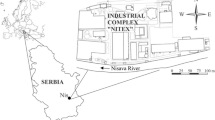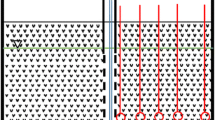Abstract
The present study was carried out with the objective of integrating physical and biological methods for the treatment of polycyclic aromatic hydrocarbons (PAHs)-contaminated groundwater and to assess its efficiency. The aquifer in Kirchseeon region, Germany, is contaminated with PAHs due to product loss of tar oil which was used in large amounts for treating the railway sleepers produced in this area. Six pumping wells, two recharge wells and fifteen observation wells were installed for this study as a part of the ex situ biodegradation treatment plant. Zoogloea, Leptothrix, Sphingomonas, Novosphingobium and Comamonadaceae were the indigenous bacteria that facilitated degradation of the PAHs. In the bioreactors, 95 % of naphthalene and methylnaphthalene and 90 % of total PAHs were removed. During this remediation process, 700,000 m3 of PAHs-contaminated groundwater was purified to almost drinking water quality. Also, 7,000 kg of dense non-aqueous phase liquid (DNAPL) and 950 kg of PAHs were removed from the pumped groundwater. The remediated groundwater is recharged back into the aquifer through two recharge wells located 600 m from the study site. The observation wells show a decrease in contamination of up to 95 %. Thus, this field scale study showed that using indigenous bacteria to remediate PAHs-contaminated groundwater is a viable option.








Similar content being viewed by others
References
Abd-Elsalam HE, Hafez EE, Hussain AA, Ali AG, El-Hanafy AA (2009) Isolation and identification of three-rings polyaromatic hydrocarbons (Anthracene and Phenanthrene) degrading bacteria. Am-Eur J Agric Environ Sci 5(1):31–38
Atanassova I, Brummer GW (2004) Polycyclic aromatic hydrocarbons of anthropogenic and biopedogenic origin in a colluviated hydromorphic soil of Western Europe. Geoderma 120:27–34
Bayerisches Geologisches Landesamt (1994) Geologische Übersichtskarte von Bayern 1:1,500,000, Munich
Bergqvist PA, Augulytė L, Jurjonienė V (2006) PAH and PCB removal efficiencies in Umeå (Sweden) and Šiauliai (Lithuania) municipal wastewater treatment plants. Water Air Soil Pollut 175(1–4):291–303
Brassington R (2013) Lessons learned about the nature of groundwater contamination by PAHs: a case history–based discussion. Rem J 23(1):103–121
Chagas-Spinelli ACO, Kato MT, de Lima ES, Gavazza S (2012) Bioremediation of a tropical clay soil contaminated with diesel oil. J Environ Manag 113:510–516
Chen B, Xuan X, Zhu L, Wang J, Gao Y, Yang K, Shen X, Lou B (2004) Distributions of polycyclic aromatic hydrocarbons in surface waters, sediments and soils of Hangzhou City, China. Water Res 38:3558–3568
Commendatore MG, Nievas ML, Amin O, Esteves JL (2012) Sources and distribution of aliphatic and polyaromatic hydrocarbons in coastal sediments from the Ushuaia Bay (Tierra del Fuego, Patagonia, Argentina. Mar Environ Res 74:20–31
Dìez B, Pedròs-Aliò C, Marsh TL, Massana R (2001) Application of denaturing gradient gel electrophoresis (DGGE) to study the diversity of marine picoeukaryotic assemblages and comparison of DGGE with other molecular techniques. Appl Environ Microbiol 67:2942–2951
Fengpeng HE, Zhihuan Z, Yunyang W, Song LU, Liang W, Qingwei BU (2009) Polycyclic aromatic hydrocarbons in soils of Beijing and Tianjin region: vertical distribution, correlation with TOC and transport mechanism. J Environ Sci 21:675–685
Gan S, Lau EV, Ng HK (2009) Remediation of soils contaminated with polycyclic aromatic hydrocarbons (PAHs). J Hazard Mater 172(2–3):532–549
GEO-data GmbH (2003) Standort 6156 Kirchseeon, Sanierungsplanung Abstromsicherung Ost, Garbsen
GEO-data GmbH (2009) Standort 6156 Kirchseeon, Projektphase SD 2; Dokumentation der Betriebsphase Abstromsicherung Ost: 1–3. Betriebsjahr (Textteil und Anlagenband), Garbsen
Guerin TF (2002) A pilot study for the selection of a bioreactor for remediation of groundwater from a coal tar contaminated site. J Hazard Mater 89(2–3):241–252
Hallberg RO, Trepte BS (2003) Bioremediation of PAH polluted soils: column studies. J Soils Sediments 3(1):21–27
Han DM, Tong XX, Jin MG, Hepburn E, Tong CS, Song XF (2013) Evaluation of organic contamination in urban groundwater surrounding a municipal landfill, Zhoukou, China. Environ Monitor Assess 185(4):3413–3444
Harayama S (1997) Polycyclic aromatic hydrocarbon bioremediation design. Curr Opin Biotechnol 8(3):268–273
Haritash AK, Kaushik CP (2009) Biodegradation aspects of polycyclic aromatic hydrocarbons (PAHs): a review. J Hazard Mater 169(1–3):1–15
Hawthorne SB, Grabanski CB (2000) Correlating selective supercritical fluid extraction with bioremediation behaviour of PAHs in a field treatment plot. Environ Sci Technol 34(19):4103–4110
International Maritime Organisation (IMO) (2004) Bioremediation of marine oil spills, p 3
Jeon CO, Park W, Padmanabhan P, DeRito C, Snape JR, Madsen EL (2003) Discovery of a bacterium, with distinctive dioxygenase, that is responsible for in situ biodegradation in contaminated sediment. Proc Natl Acad Sci 100:13591–13596
Kordybach BM, Smreczak B, Pawlas AK (2009) Concentrations, sources, and spatial distribution of individual polycyclic aromatic hydrocarbons (PAHs) in agricultural soils in the Eastern part of the EU: Poland as a case study. Sci Total Environ 407:3746–3753
Li X, Li P, Lin X, Zhang C, Li Q, Gong Z (2008) Biodegradation of aged polycyclic aromatic hydrocarbons (PAHs) by microbial consortia in soil and slurry phases. J Hazard Mater 150(1):21–26
Li J, Shanga X, Zhaoa Z, Tanguaya RL, Donga Q, Huanga C (2010) Polycyclic aromatic hydrocarbons in water, sediment, soil, and plants of the Aojiang River waterway in Wenzhou, China. J Hazard Mater 173(1–3):75–81
Liang Y, Zhang X, Wang J, Li G (2012) Spatial variations of hydrocarbon contamination and soil properties in oil exploring fields across China. J Hazard Mater 241–242:371–378
Limam I, Driss MR (2013) Off-line solid-phase extraction procedure for the determination of polycyclic aromatic hydrocarbons from aqueous matrices. Int J Environ Sci Tech 10(5):973–982
Lladó S, Covino S, Solanas AM, Viñas M, Petruccioli M, D’annibale A (2013) Comparative assessment of bioremediation approaches to highly recalcitrant PAH degradation in a real industrial polluted soil. J Hazard Mater. doi:10.1016/j.jhazmat.2013.01.020
Lors C, Damidot D, Ponge JF, Périé F (2012) Comparison of a bioremediation process of PAHs in a PAH-contaminated soil at field and laboratory scales. Environ Pollut 165:11–17
Mao J, Luo Y, Teng Y, Li Z (2012) Bioremediation of polycyclic aromatic hydrocarbon-contaminated soil by a bacterial consortium and associated microbial community changes. Int Biodeterioration Biodegradation 70:141–147
Menendez-Vega D, Gallego JLR, Pelaez AI, de Cordoba GF, Moreno J, Muñoz D, Sanchez J (2007) Engineered in situ bioremediation of soil and groundwater polluted with weathered hydrocarbons. Eur J Soil Biol 43(5–6):310–321
Menzie CA, Potokib B (1992) Exposure to carcinogenic PAHs in the environment. Environ Sci Technol 26:1278–1284
Miguel VS, Peinado C, Catalina F, Abrusci C (2009) Bioremediation of naphthalene in water by Sphingomonas paucimobilis using new biodegradable surfactants based on poly (-caprolactone). Int Biodeterioration Biodegradation 63(2):217–223
Moscoso F, Teijiz I, Deive FJ, Sanromán MA (2012) Efficient PAHs biodegradation by a bacterial consortium at flask and bioreactor scale. Bioresource Techn 119:270–276
Muangchinda C, Pansri R, Wongwongsee W, Pinyakong O (2013) Assessment of polycyclic aromatic hydrocarbon biodegradation potential in mangrove sediment from Don Hoi Lot, Samut Songkram Province, Thailand. J Appl Microbiol. doi:10.1111/jam.12128
Muyzer G, Hottenträger S, Teske A, Waver C (1995) Denaturing gradient gel electrophoresis of PCR-amplified 16S rDNA—a new molecular approach to analyse the genetic diversity of mixed microbial communities, In: Akkermans ADL, van Elsas JD, de Bruijn FJ (eds) Molecular microbial ecology manual, 2nd ed. Kluwer, Dordrecht, pp 3.4.4.1–3.4.4.22
Neuhauser EF, Ripp JA, Azzolina NA, Madsen EL, Mauro DM, Taylor T (2009) Monitored natural attenuation of manufactured gas plant tar mono and polycyclic aromatic hydrocarbons in ground water: a 14-Year Field Study. Ground Water Monit Rem 29(3):66–76
Pandey PK, Patel KS, Lenicek J (1999) Polycyclic aromatic hydrocarbons: need for assessment of health risks in India? Study of an urban-industrial location in India. Environ Monit Assess 59:287–319
Penet S, Marchal R, Sghir A, Monot F (2004) Biodegradation of hydrocarbon cuts used for diesel oil formulation. Appl Microbiol Biotechnol 66:40–47
Rogozinski LR, Laubaucher RC, Farmer JM (1992) Groundwater treatment via constructed wetlands. Presented at the petroleum hydrocarbons conference, November 4–6, 1992, Houston
Seo Y, Jang A, Bishop PL (2007) Organic mulch biowall for PAH contaminated groundwater remediation. Eur J Soil Biol 43(5–6):304–309
Silva-Castro GA, Rodelas B, Perucha C, Laguna J, González-López J, Calvo C (2013) Bioremediation of diesel-polluted soil using biostimulation as post-treatment after oxidation with Fenton-like reagents: assays in a pilot plant. Sci Total Environ 445–446:347–355
Thavamani P, Megharaj M, Naidu R (2012) Multivariate analysis of mixed contaminants (PAHs and heavy metals) at manufactured gas plant site soils. Environ Monit Assess 184(6):3875–3885
Trably E, Patureau D (2006) Successful treatment of low PAH-contaminated sewage sludge in aerobic bioreactors. Environ Sci Pollut Res Int 13(3):170–176
USEPA (2001) Report of the remediation system evaluation (document no. EPA 542-R-02-008f). pp 1–25. Available from; www.epa.gov/tio or www.cluin.org/rse. Accessed on 16th July 2011
Valderrama C, Gamisans X, Cortina JL, Farrán A, De las Heras FX (2009) Evaluation of polyaromatic hydrocarbon removal from aqueous solutions using activated carbon and hyper-crosslinked polymer (Macronet MN200). J Chem Technol Biotechnol 84:236–245
Vázquez S, Nogales B, Ruberto L, Mestre C, Christie-Oleza J, Ferrero M, Bosch R, Mac Cormack WP (2013) Characterization of bacterial consortia from diesel-contaminated Antarctic soils: towards the design of tailored formulas for bioaugmentation. Int Biodeterioration Biodegradation 77:22–30
Vitte I, Duran R, Jézéquel R, Caumette P, Cravo-Laureau C (2011) Effect of oxic/anoxic switches on bacterial communities and PAH biodegradation in an oil-contaminated sludge. Environ Sci Pollut Res 18(6):1022–1032
Wang X, Yu X, Bartha R (1990) Effect of bioremediation on polycyclic aromatic hydrocarbon residues in soil. Environ Sci Technol 24(7):1086–1089
Watson SW, Novitsky TJ, Quinby HL, Valois FW (1977) Determination of bacterial number and biomass in the marine environment. Appl Environ Microbiol 33:940–946
Yagi JM, Neuhauser EF, Ripp JA, Mauro DM, Madsen EL (2010) Subsurface ecosystem resilience: long-term attenuation of subsurface contaminants supports a dynamic microbial community. ISME J 4(1):131–143
Zhang H, Kallimanis A, Koukkou AI, Drainas C (2004) Isolation and characterization of novel bacteria degrading polycyclic aromatic hydrocarbons from polluted Greek soils. Appl Microbiol Biotechnol 65:124–131
Zhang J, Dai J, Chen H, Du X, Wang W, Wang R (2012) Petroleum contamination in groundwater/air and its effects on farmland soil in the outskirt of an industrial city in China. J Geochem Explor 118:19–29
Zhu L, Chen Y, Zhou R (2008) Distribution of polycyclic aromatic hydrocarbons in water, sediment and soil in drinking water resource of Zhejiang Province, China. J Hazard Mater 150:308–316
Acknowledgments
We thank Jörg Overmann and Martina Mayer (Department of Biology—Microbiology, LMU-München, Munich, Germany) for microbiological investigations, also Jan Jungblut and Erhard Reutter (GEO-data GmbH, Garbsen, Germany) for their contribution and enriching discussion. The second author wishes to thank Mrs. Dagmar Vogel, DB AG Sanierungsmanagement, München, for her great support and supervision. We thank Dr. Brindha Karthikeyan, Research Associate, Anna University for her critical comments and assistance in the preparation of this manuscript.
Author information
Authors and Affiliations
Corresponding author
Rights and permissions
About this article
Cite this article
Höckenreiner, M., Neugebauer, H. & Elango, L. Ex situ bioremediation method for the treatment of groundwater contaminated with PAHs. Int. J. Environ. Sci. Technol. 12, 285–296 (2015). https://doi.org/10.1007/s13762-013-0427-5
Received:
Revised:
Accepted:
Published:
Issue Date:
DOI: https://doi.org/10.1007/s13762-013-0427-5




